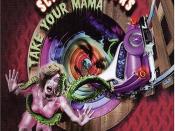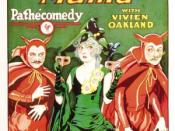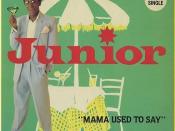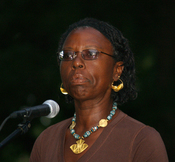In 1966, Barbara Welter studied countless amounts of literature that was aimed at the female audience of the nineteenth century with the goal of discovering the roots of sexual stereotypes. She published these findings in ÃÂThe Cult of True Womanhood: 1820-1860.ÃÂ ÃÂThe Cult of True WomanhoodÃÂ outlines, in a tongue-in-cheek fashion, the standards that woman of the time were held to. Though the ÃÂCult of True WomanhoodÃÂ was based off of the lives of middle-class white women, all women of every class and race were expected to portray the features of the ÃÂTrue Woman.ÃÂ According to WelterÃÂs article, women were expected to uphold ÃÂfour cardinal virtuesÃÂpiety, purity, submissiveness, and domesticity,ÃÂ (Welter 115). These four pillars of ÃÂTrue WomanhoodÃÂ are disputed in Gloria NaylorÃÂs novel Mama Day. Mama Day tells the story of a marriage between a successful black businessman named George, who has grown up in New York City without any real family, and Cocoa (also referred to as Ophelia), a young black woman uneasy about her identity as she attempts to balance her past as a small-town southerner with her present life trying to make it in the bustling city of New York.
The story reaches its climax when the two visit Cocoa's home in Willow SpringsÃÂa small island not found on any maps where the two women most influential in her life reside: her grandmother (Abigail) and great-aunt (Mama Day). Through the two core characters (George and Cocoa) and their relationship with one another, as well as the other individuals on Willow Springs, the four virtues laid out in ÃÂThe Cult of True WomanhoodÃÂ are challenged through methods such as role reversals, the defiance of the ÃÂTrue WomanÃÂ stereotype, and the praise and reenvisioning of matriarchal power.
Throughout NaylorÃÂs Mama Day, a clear role reversal is witnessed in George and CocoaÃÂs relationship that controverts the domestic and submissive virtues described by Welter. ÃÂThe Cult of True WomanhoodÃÂ asserts that ÃÂmen were the movers, the doers, the actorsÃÂ while ÃÂ[w]omen were the passive, submissive respondersÃÂ (Welter 118). But, this order was not so between Cocoa and George. Naylor depicts Cocoa as just as much of a ÃÂmoverÃÂ ÃÂdoerÃÂ and ÃÂactorÃÂ as George and more times than not, George is the ÃÂpassive, submissive responder.ÃÂ An excellent presentation of George as the responder and Cocoa as the initiator and driving force is seen within the very framework of the novel. The way that Naylor sets up the points of view is such that Cocoa is the initial speaker; Naylor is sure to recant CocoaÃÂs version of the sequence of events first, and then GeorgeÃÂs account follows. Additionally, Cocoa is the last to speak, and even stating, ÃÂ[W]hen I see you again, our versions will be different still,ÃÂ (Naylor 310). In the end, Naylor makes certain that Cocoa gets the last word in, and her version of the events is the only one to be told, perhaps as its importance is greater than that of hisÃÂsomething that goes against the purported ÃÂconsciousÃÂ inferiorityÃÂ (Welter 118) women were supposed to display, according to ÃÂThe Cult of True Womanhood.ÃÂ In fact, certainly the very act of Naylor making the point of having the woman get the last word instead of the man demonstrates superiority rather than inferiority.
Role reversals are not only seen in the structure of the novel, but also within its content. According to ÃÂThe Cult of True Womanhood,ÃÂ two explicit qualities that men should possess that women should not are ÃÂfirmnessÃÂ and ÃÂperseveranceÃÂ (Welter 118). However, throughout Mama Day, it is often Cocoa who is insistent with George and not the other way around. A great example of this is when George wants to move to Willow Springs with Cocoa, but Cocoa is the one to put her foot down and refuseÃÂknowing full well it is a terrible idea for them. Afterwards, George admits through his internal monologue that he put her ÃÂinto an unfair position,ÃÂ and that Cocoa was ÃÂ[r]ealisticallyÃÂ rightÃÂ (Naylor 221). These role reversals between Cocoa and George are depicted by Naylor on numerous occasions throughout the text, and through these inversions, Naylor successfully confutes the domestic and submissive virtues outlined in ÃÂThe Cult of True Womanhood.ÃÂThrough the deviances from the stereotype portrayed in WelterÃÂs article, the characters in Mama Day defy the cardinal virtues that presumably defined women. ÃÂThe Cult of True WomanhoodÃÂ paints a picture of the attractive attributes of a woman as someone who possesses ÃÂa spirit of obedience and submission, pliability of temper, and humility of mind,ÃÂ (Welter 118). However, the men in Mama Day seem to find other qualities appealing. For instance, upon first meeting Cocoa, George states in an internal dialogue, ÃÂYou had spunk, Ophelia, and thatÃÂs what I admired in a woman,ÃÂ (Naylor 31). His admiration of her toughness is in direct contrast with the submissive characteristic that is so praised of women in WelterÃÂs article: ÃÂSubmission was perhaps the most feminine virtue expected of women,ÃÂ (Welter 118). Additionally, the ÃÂpliability of temperÃÂ that is supposedly required of women, according to ÃÂThe Cult of True Womanhood,ÃÂ is not seen in CocoaÃÂs character in the least; her temperament is anything but malleable. For example, Cocoa and George get into a very heated argument right before a party in Willow Springs where George is to meet all of the residents. Cocoa flies off the handle after George says he does not hate her foundation, but doesnÃÂt comment on particularly liking it either: ÃÂI guess you think IÃÂm stupidÃÂor deaf. Not hating something isnÃÂt the same as liking itÃÂ (Naylor 231). This progresses into their ÃÂworst fight everÃÂ (Naylor 230). ÃÂThe Cult of True WomanhoodÃÂ states that this type of inflexible attitude should not be tolerated of women. The ÃÂTrue WomanÃÂ would not have taken any offence at all, and if anything, would have thanked George. The act of questioning the man and accusing him of wrongdoing would not be in accordance with the ÃÂpassive virtuesÃÂ (Welter 118) necessary in women. Domesticity is yet another virtue challenged through CocoaÃÂs deviation from the ÃÂTrue WomanÃÂ image. ÃÂThe Cult of True WomanhoodÃÂ states that ÃÂdomesticity [is] among the virtues most prizedÃÂ (Welter 118), and criticizes women who seek higher education, yet George wholeheartedly supports Cocoa while she works towards, and finishes her history degree. The fact that he endorses this is a complete disparity from the apparent ÃÂfear of ÃÂblue stockingsÃÂÃÂ (Welter 119) that men are supposed to have of women who are educated. Divergences from the stereotypic female norm of WelterÃÂs article are encountered countless times within NaylorÃÂs novel.
The notion given by ÃÂThe Cult of True WomanhoodÃÂ that all women should be ÃÂweakÃÂ and ÃÂinferiorÃÂ (Welter 118) is defied through NaylorÃÂs representation of Mama Day and Abigail as powerful, matriarchal figures. Though the image of the matriarch is often criticized when attributed to African American women, Naylor reenvisions this image and transforms the negative connotations perceived by individuals such as Patricia Hill Collins into more positive attributes that can be seen in a new light. Collins discusses the image of matriarchs as being ÃÂunfeminine,ÃÂ and ÃÂa major contributing factor to their childrenÃÂsÃÂ failure[s]ÃÂ (Collins 74). However, within Mama Day, the two matriarchal figures, Mama Day and Abigail, are neither of these things. In fact, they are quite the opposite. Naylor describes Abigail as ÃÂa beautiful womanÃÂ who is ÃÂable to turn a few heads.ÃÂ And even states that ÃÂ[a]ge only done softened [her] olive brown fleshÃÂ (Naylor 44). The fact that her description is of a quite attractive, feminine woman is in direct contrast with the conception laid out in CollinsÃÂ article that all matriarchs are ÃÂunfeminine.ÃÂ Additionally, the perception that matriarchal woman do not ÃÂproperly supervise their childrenÃÂ (Collins 74) and cause failure to their offspring is refuted through CocoaÃÂs constant praise of the two women in Willow Springs who raised her. But, it is not just Cocoa who has a ridiculous amount of respect for the womenÃÂit is nearly every individual in Willow Springs. The women, namely Mama Day, basically run the island. Mama Day holds a sense of power over the island that no man can; the notion laid out in ÃÂThe Cult of True WomanhoodÃÂ that women ÃÂshould submitÃÂ (Welter 118) to men is constantly challenged by Mama DayÃÂs character. One illustration of this is seen after George tells Mama Day that Dr. Buzzard said ÃÂthere was a little professional rivalry betweenÃÂ Mama Day and he. Mama Day does not even allow George to finish his sentence before she erupts at him, causing him to ÃÂback away from the thunder in [her] voiceÃÂ (Naylor 196). His apparent fear of her does not corroborate her as ÃÂweak and timidÃÂ (Welter 118) like she should be according to WelterÃÂs article. Naylor effectively transforms the negative image of the African- American matriarch by bathing both Mama Day and Abigail in a nearly constant positive and respected light.
Barbara WelterÃÂs article ÃÂThe Cult of True WomanhoodÃÂ declares that the four cardinal virtues together compiled what it is to be a ÃÂmother, daughter, sister, wifeÃÂwomanÃÂ and that without these virtues, ÃÂall [is] ashesÃÂ (Welter 115); however, Gloria NaylorÃÂs Mama Day successfully disproves this by completely denouncing these virtues. She accomplishes this intricately complicated task through an inversion of the gender roles within George and CocoaÃÂs relationship, strong aberrations from stereotypes, and the re-conceptualization of matriarchal power. By taking these steps, Naylor efficiently casts aside the image of a docile, inferior, submissive woman, and allows for the mixing and switching of typical, gender-oriented stereotypes.
Bibliography:Naylor, Gloria. Mama Day. New York: Vintage, 1989Welter, Barbara. The Cult of True Womanhood, 1820-1860. In American Quarterly, XVIII (1966), 151-74.





